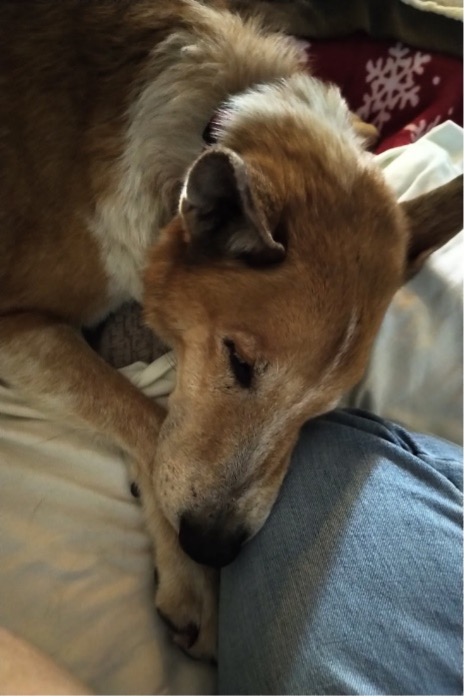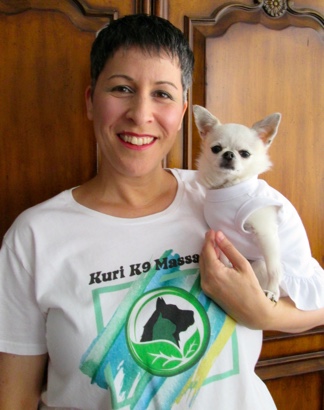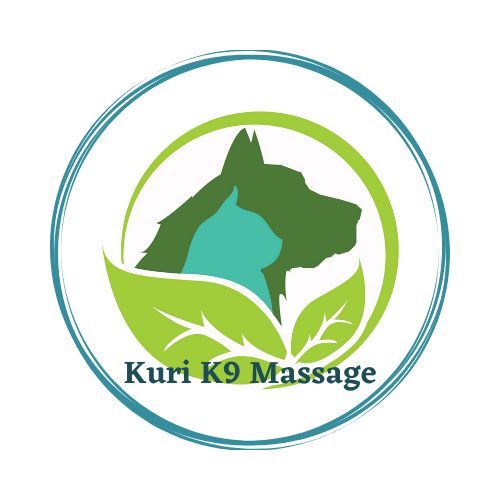Let me tell you a little bit about one of my senior canine clients – Jefferson. He was the mascot for MyNextRace.com and was closing in on 16 years of age before he crossed over to Rainbow Bridge, which is no mean feat for a medium to large-sized mixed-breed dog.
But not just that…this guy was still walking. Yes, he had issues with his hind legs for sure (that’s where I came in, along with his meds, and movement), and he would sometimes collapse, but Jefferson was still going for hour-long walks, however slowly he needed to go. His quality of life was still significant during the bulk of the time I was going to see him.
My job as Jefferson’s massage therapist was to help ease the discomfort in his hind legs, as well as the compensation issues that would come up with his forelegs, shoulders, and back. Such is usually the case for most of my senior dog and cat clients. Any dog or cat of any size, age, breed, or activity level can benefit from massage, but senior pets benefit especially. Massage increases the blood supply to muscles, bringing much-needed oxygen and nutrients to the muscle tissues. Supporting this basic function becomes even more important as a pet ages.
Massage strokes can also help prevent lesions as well as loosening and stretching muscles, tendons, and ligaments. Range of motion is increased, allowing more free movement and gained strength. And increased muscle tone equals increased elasticity. As a pet ages, the probability of joint issues including arthritis increases, which was one of the issues with Jefferson. Massage becomes not only a preventive measure but a method of relieving pain caused by muscle spasms and tightness in tendons and ligaments.
Massage also prevents muscle atrophy in inactive muscles—an issue many older dogs and cats face. Nourished joints are also well-lubricated joints, which helps to maintain or increase range of motion. Massage improves circulation overall, affecting the flow of blood, encouraging veins to carry away waste products, and arteries to carry a steady flow of oxygen and nutrients to keep cells healthy. Circulation is a big deal for older pets, as long as they aren’t suffering from something like heart disease, kidney issues, epilepsy, or diabetes, where an increase in circulation by massage would be contraindicated.
But contraindication doesn’t mean massage has to be eliminated entirely. In some cases, I can modify the massage, so that it doesn’t overstimulate the circulatory system. In Jefferson’s case, I needed to avoid overstimulating his digestive system so it wouldn’t be thrown completely out of whack. The last thing a senior dog needs is an upset stomach or diarrhea that can be avoided. So, Jefferson’s massages were light and brief and intended to support his meds in easing pain and improving range of motion, which meant he could keep walking a little longer. And because he could keep up with his walks, this movement also kept his joints lubricated. We achieved a positive cycle where massage kept him moving and his moving kept his muscles and joints in better condition than they otherwise would have been, supporting future massage therapy with more positive results. And this maintenance continues with a senior pet for as long as possible.
There are multiple other ways that massage helps a pet age and live their senior years more gracefully. Lymphatic circulation is also increased by massage, draining lymph fluid into glands where it can be cleansed of toxins. Massage even improves lung conditions by increasing the flow of blood. The heat created by massage can also soften fat tissue, breaking down solid fat deposits—coupled with a scheme of weight reduction and exercise, this can help slim a dog down. Older dogs and cats are a little more likely to be overweight or even obese, which is also hard on their joints.
Jefferson’s journey provided me with a lot of insight into this late stage of senior canine life. I hope his story might answer questions you have about your own senior dog (or your older cat). Or you may have learned something new that will prepare you for your pet’s later years. Mostly I want you to know that senior years can be quality years for a surprisingly long time, and that’s one of many ways massage therapy can help.
Jefferson leaning on Regan’s knee post massage session

Watch example videos of senior pets enjoying their massages:
Ziggy’s (Senior Chihuahua cross) first massage: https://www.youtube.com/watch?v=qnPqeM9G4fo
Max’s (14 year old Chiweenie) massage: https://www.youtube.com/watch?v=cmeswEj5wIc
Nefertiti’s (17 year old British Longhair mix) massage: https://www.youtube.com/watch?v=zTieKrvJSgk
Casper’s (14 year old Domestic Shorthair) massage: https://www.youtube.com/watch?v=R3XMC_rDa1M
Article by Regan Macaulay, Owner of Kuri K9 Massage
After extensive training through Treetops Animal Massage Certification Program (Ontario), I started my mobile business, Kuri K9 Massage in 2013 to help Toronto and GTA pets live healthier, happier lives by relieving physical and emotional pain and tension, thereby also relieving stress for fur baby moms and dads—boosting quality of life together for longer. I offer Swedish massage therapy to dogs and cats young and old, as well as reflexology, lymphatic drainage massage, sports massage, acupressure, and hydrotherapy wraps, as well as distance Reiki.
Website: https://www.kurik9massage.com/
Instagram: kurik9massage
Facebook: Kuri K9 Massage






